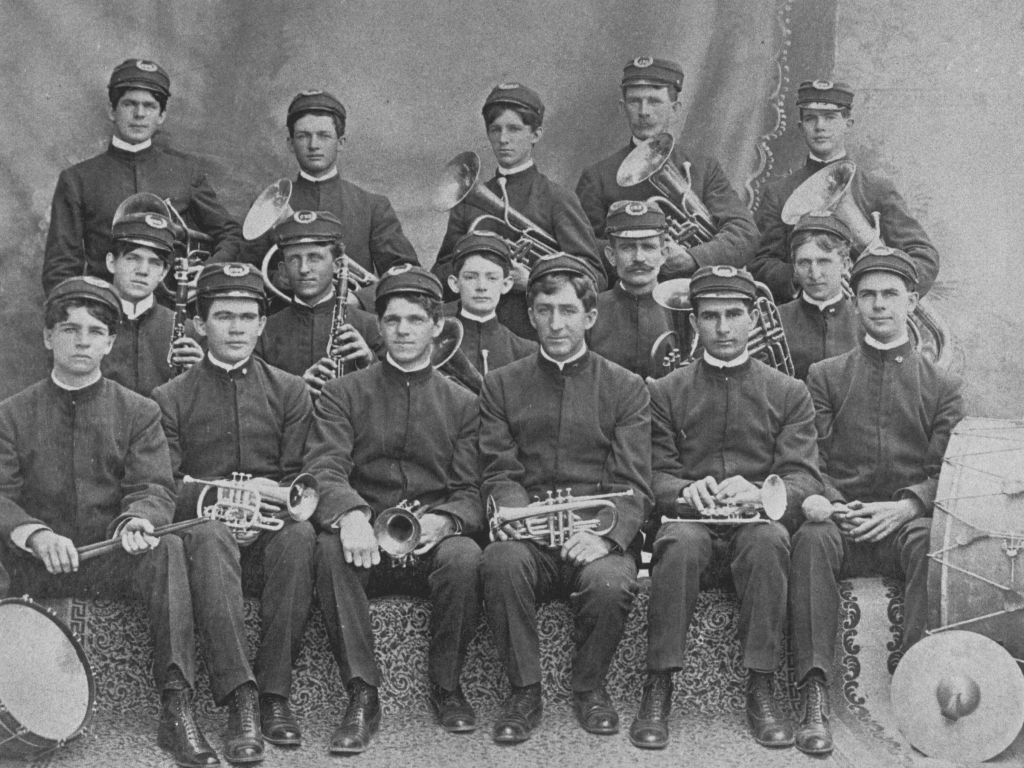
Jasper M. Harwell, a farmer and native of Tennessee, married Mary Logan in Murfreesboro, Arkansas on Oct. 24, 1876. They arrived in Santa Rosa in 1884 and moved to Clovis in 1901. They raised a family of five sons: Otis, Eugene, Ernest, Bert (Charles Albert) and Clarence. Their two daughters would marry Nichols brothers. Leona married Gordon and Ophelia married Oscar.
Jasper and Mary celebrated their 65th wedding anniversary in 1941. A total of 16 grandchildren and 22 great grandchildren attended the celebration.
In 1902, Jasper opened a furniture store on the northeast side of Fifth Street between Pollasky and Front Street (Clovis Avenue). He also built a two story house at 434 Pollasky where Emil’s Barber Shop was later located. The musical family would serenade the town from their upstairs veranda.
In 1903, the Harwells founded the first Clovis Brass Band. Otis was the director while employed at a furniture store. Ernest, Bert and Eugene worked at the Fresno Flume and Irrigation Company which was located at the Clovis Rodeo grounds. Clarence was a Clovis Elementary School student.
Bert graduated from Clovis High in 1910 and became a nationally known Ornithologist (Zoology, study of birds). He served as Pacific Coast Director of the Junior Red Cross and as a park naturalist at Yosemite National Park.
On Feb. 15, 1927, a Clovis audience gathered at Clovis High School auditorium to hear his radio presentation of bird calls and songs. He could imitate 400 bird songs. A 1959 National Audubon Society article stated he worked with Disney Studio on “The Vanishing Prairie” and “Water Birds” productions.
Clarence and Otis became Methodist ministers. Clarence stated his mother would send him out to watch birds to keep him busy. He was a gifted musician. He composed many songs but did not publish them.
Otis invented a rotary scraper for leveling land. He also served as band master. His programs always provided patriotic and terpsichorean (dance music).
An article described Ernest Harwell: “He holds the belt as a grape picker with 126 boxes (46 pounds each) to his credit. Filling 106 boxes (5,706 pounds) yielded him $5.04 for a day of work. His record was made at Burford’s vineyard west of Clovis.
Ernest invented the Harmophone which was a pitch raiser for the harmonica. He sold the assemble instructions for 50 cents and declared any child could make it.
He also invented the Fillzitt percolator that would capture automobile steam and return the water to the radiator. It would be tested on “Rim of the World” perilous drive from San Bernardino to Bear Valley. He formed a partnership with brothers Otis and Eugene. Their product sold for $4.50 each. Their first production filled 40 cash orders.
In 1921, Ernie organized the Clovis Community Band. Over 39 Clovis merchants would sponsor the community event. Each would contribute $1 per month for six months. Band members would pay $1 for three months. Fresno County Supervisor Robert Lochhead also contributed financial support. The donations were used to purchase instruments.
A favorite tune at the time: “Turn up the Radio, the Bee is Buzzing Dear.” The band would practice every Monday evening at Judge Beall’s courtroom 401 Pollasky. The Clovis Museum is now located there.
The Fresno Bee published numerous “Letters to the Editor” by Ernie. His passion for his community, country and concern for the well being of all was constant theme. Our next article will share some of his thoughts.
The Harwells left us a rich heritage.








